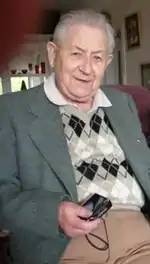Andrew Donald Booth
Andrew Donald Booth (11 February 1918 – 29 November 2009)[2][3] was a British electrical engineer, physicist and computer scientist, who was an early developer of the magnetic drum memory for computers.[1] He is known for Booth's multiplication algorithm.[2] In his later career in Canada he became president of Lakehead University.
Andrew Donald Booth | |
|---|---|
 Booth in 2008 | |
| Born | 11 February 1918 |
| Died | 29 November 2009 (aged 91) |
| Nationality | English |
| Alma mater | Jesus College |
| Known for | Booth's multiplication algorithm |
| Spouse | Kathleen Booth |
| Scientific career | |
| Fields | Computer science, Physics, Electric engineering |
| Institutions | Birkbeck College, University of London, Lakehead University |
Early life
Andrew Donald Booth was born on February 11, 1918 in East Molesy, Surrey, UK.[4] He was the son of Sidney Booth (died 1955) and a cousin of Sir Felix Booth.
He was raised in Weybridge, Surrey, and educated at Haberdashers' Aske's Boys' School. In 1937, he won a scholarship to read mathematics at Jesus College, Cambridge. Booth left Cambridge without taking a degree, having become disaffected with pure mathematics as a subject. He chose an external degree from the University of London instead, which he obtained with a first.[2]
Career
From 1943 to 1945, Booth worked as a mathematical physicist in the X-ray team at the British Rubber Producers' Research Association (BRPRA), Welwyn Garden City, Hertfordshire, gaining his PhD in crystallography from the University of Birmingham in 1944. In 1945, he moved to Birkbeck College, University of London, where his work in the crystallography group led him to build some of the first electronic computers in the United Kingdom[5][6] including the All Purpose Electronic Computer, first installed at the British Rayon Research Association.[7] Booth founded Birkbeck's department of numerical automation and was named a fellow at the university in 2004.[8] He also did early pioneering work in machine translation.[9]
After World War II, he worked on crystallographic problems research at Birkbeck College and constructed a fourier synthesis device. He was then introduced to the work of Alan Turing and John von Neumann on logical automata by Douglas Hartree.[4]
Dr. Booth served as President of Lakehead University from 1972 to 1978.
Personal life
Booth married mathematician and computer engineer Kathleen Britten in 1950, and had two children, Amanda and Ian;[10] between 1947 and 1953, together they produced three computing machines.
See also
Bibliography
- School of computer science and information systems: A short history (PDF), 50 years of Computing, UK: Birkbeck School of Computing, 2008
- Coding system for the APE(X)C, AU: Murdoch, archived from the original on 7 June 2011, retrieved 2 November 2018.
- Booth, A.D. and Britten, K.H.V. (1947) Coding for A.R.C., Institute for Advanced Study, Princeton
- Booth, A.D. and Britten, K.H.V. (1947) General considerations in the design of an all-purpose electronic digital computer, Institute for Advance Study, Princeton
- Booth, A.D. and Britten, K.H.V. (1948) The accuracy of atomic co-ordinates derived from Fourier series in X-ray crystallography Part V, Proc. Roy. Soc. Vol A 193 pp305–310
- The Electronic Principles of Digital Computers, Electronics Forum (1948);
- Booth, Andrew D; Britten, Kathleen HV (September 1947), "Principles and Progress in the Construction of High-Speed Digital Computers", Quart. Journ. Mech. And Applied Math., 2 (2): 182–197, doi:10.1093/qjmam/2.2.182.
- Booth, A.D (1949) A Magnetic Digital Storage System, Electronic Engineering
- Booth, A.D. (1950) The Physical Realization of An Electronic Digital Computer, Electronic Engineering
- Booth, A.D. (1952) On Optimum Relations Between Circuit Elements and Logical Symbols in the Design of Electronic Calculators, Journal of British Institution of Radio Engineers
- Booth, A.D. and Booth K.H.V. (1953) Automatic Digital Calculators, Butterworth-Heinmann (Academic Press) London
References
- International Biographical Dictionary of Computer Pioneers. John A.N. Lee. November 1995. p. 115. ISBN 1-884964-47-8.
Born February 11 1918, East Molesy, Surrey, UK; early computer developer at the University of London who worked with John von Neumann; with Warren Weaver in 1946, first conceived of machine translations, and manufactured magnetic drum memories for many early computers.
- Andrew Booth: scientist who invented the magnetic storage device, The Times, 12 January 2010.
- Johnson, Roger (Summer 2010). "Pioneer Profile: Andrew Booth". Resurrection - Computer Conservation Society. Vol. 51. ISSN 0958-7403. Retrieved 29 July 2010.
- "Andrew Donald Booth". IEEE Computer Society. Retrieved 4 September 2023.
- The work of Professor Andrew D. Booth Archived 23 September 2015 at the Wayback Machine, Department of Computer Science, Birkbeck College, London, UK.
- Collin, Andrew. Andrew Booth's Computers at Birkbeck College. Resurrection, Issue 5, Spring 1993. London: Computer Conservation Society.
- "Archived copy". Archived from the original on 6 May 2011. Retrieved 2 January 2011.
{{cite web}}: CS1 maint: archived copy as title (link) Computer Science at Birkbeck College - "Obituary: Professor Andrew Booth". Retrieved 17 September 2023.
- Booth, Andrew (2003). H. L. Somers (ed.). Mechanical Translation. Readings in machine translation. MIT Press. ISBN 9780262140744.
- "Pioneer of the hard drive". Susan Lazaruk. 3 January 2010. Retrieved 28 March 2021 – via PressReader.
Booth and his wife raised two children, Amanda, a veterinarian, and Ian, a physicist.